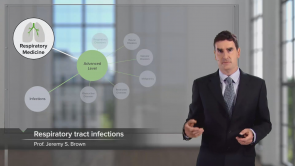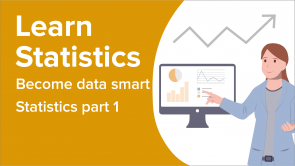Linear Regression

Über den Vortrag
Der Vortrag „Linear Regression“ von David Spade, PhD ist Bestandteil des Kurses „Statistics Part 1“. Der Vortrag ist dabei in folgende Kapitel unterteilt:
- Linear Regression
- The Y-Intercept
- Making Predictions
- The R-squared Quantity
- After Regression
Quiz zum Vortrag
Which of the following is not true of the linear model?
- The line represented by the linear model goes through every data point.
- The linear model is the equation of a straight line that goes through our data.
- The linear model can be used to model the relationship between two quantitative variables.
- A line with a good fit will have small residuals.
- The linear model cannot be used for qualitative variables.
Which of the following is not true of the relationship between linear regression and correlation?
- The slope of the regression line is equal to the correlation.
- Correlation can, in many cases, give insight into how well the linear model will fit our data.
- We must be careful in using correlation to describe how well the linear model will fit our data.
- Correlation tells us whether the slope of the regression line is positive or negative.
- The intersection of the y-axis does not provide meaningful information about correlation.
Suppose the variables X and Y are linearly related through the regression equation Y= 12.5 - 0.275 X. What do we know from this equation?
- For a one-unit increase in the value of X, we expect a decrease of 0.275 units in the value of Y.
- For a one-unit increase in the value of X, we expect an increase of 0.275 in the value of Y.
- For a one-unit increase in the value of X , we expect a 12.5 unit increase in the value of Y .
- If Y = 0, then X = 12.5.
- For a one-unit decrease in the value of X, we expect a decrease of 0.275 units in the value of Y.
Which of the following is not true of the R² quantity?
- High values of R² mean that the changes in the value of X cause the changes in the value of Y.
- The R² quantity can be used to assess how well the line fits the data in many cases.
- The R² quantity provides the percentage of variation in the response variable that is explained by the regression on the explanatory variable.
- The R² quantity is calculated by squaring the correlation.
- R² ranges from 0 to 1.
What defines the residual value of a regression line?
- The vertical distance from the observed value to the regression line
- The horizontal distance from the observed value to the regression line
- The vertical distance from the expected value to the regression line
- The horizontal distance from the expected value to the regression line
- The lateral distance from the expected value to the regression line
Suppose the relationship between age and earnings could be represented by the linear regression equation Earnings = 100 + 0.8*Age. What would be the estimated earnings of a person whose age is 43?
- 134.4
- 30
- -34.4
- 34.4
- 100
Suppose the relationship between age and earnings could be represented by the linear regression equation Earnings = 100 + 0.8*Age. The actual earnings of a person aged 43 are $150. What is the residual error?
- 15.6
- 0
- -15.6
- 34.4
- 100
Suppose the correlation between two variables is 0.75, standard deviation of y variable is 5 and the standard deviation of x variable is 2.5. What is the slope of the regression line?
- 1.5
- 0
- 1
- 0.375
- 0.75
Suppose the slope of regression line is 2 and Y variable is 10 when X variable is 3. What is the value of the intercept of the regression equation?
- 4
- 0
- 1
- 2
- 3
If a rise in health expenditure leads to a positive linear rise in GDP, then which regression equation is likely to represent their relationship?
- GDP = 100 + 0.9* Health expenditure
- GDP = 100 – 0.9* Health expenditure
- GDP = 100 + 0.9* Health expenditure + 0.23* Health expenditure²
- Health expenditure = 100 – 0.9*GDP
- Health expenditure = 100 + 0.9*GDP
Kundenrezensionen
5,0 von 5 Sternen
| 5 Sterne |
|
5 |
| 4 Sterne |
|
0 |
| 3 Sterne |
|
0 |
| 2 Sterne |
|
0 |
| 1 Stern |
|
0 |





